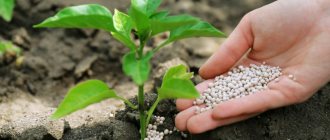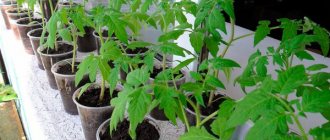We always try to grow the harvest of vegetables, fruits or berries in the best possible way, we surround the beds with care and attention. Why are carrots clumsy and horny, or sometimes ugly, instead of beautiful, smooth root crops from the picture on the package with seeds? What is the reason why the process of growth, ripening of fruits is not going according to plan - let's find out.
Gnarled carrots are not only unattractive in appearance, they are poorly cleaned, stored, and they are not at all happy with their taste. Some gardeners sin on the quality of the seeds or the dishonesty of the producers of the planting material, but in fact the reason is completely different.
Gnarled root vegetable, photo:

Why do horned carrots grow?
Let's consider the reasons in order:
- Pay attention to the soil - it should not be heavy, rocky or clayey. The soil for planting carrots should be loose. Ideal with enough sand mixed. To obtain high-quality root crops, do not be too lazy to manually mix the soil with sand (or compost, sawdust) in advance on the site of the proposed beds. Strongly compacted soil that does not allow air to pass through is an obstacle to the normal development of carrots. In order for the soil to settle, to be ideal for planting, prepare the beds in the fall - dig them up (about 20 cm deep), and in the spring, repeat this action about two weeks before sowing the seeds.
- Unsuitable fertilizers are a fairly common mistake of gardeners. Fresh manure or unripe humus should not be applied to carrot beds. By and large, organics are good for tomatoes, onions, cucumbers or potatoes, but not for carrots. However, even for these crops, organic fertilizing should not be fresh, it is better that they "stand well", quail. It is impossible to apply lime fertilizers before the sowing itself, as well as wood ash. Potassium supplements such as dolomite flour, potassium chloride or potassium salt are also strongly discouraged.
- Root damage at the initial stage of root development is a common cause of curvature, the appearance of multiple “tails”. It is advisable to find out the reason for this phenomenon. The first is too long germination of seeds, when the roots have already been born, but were damaged when they were buried. The second is the drying out of the soil at the most critical stage of growth. This is the time before the appearance of the first sprouts, the first weeks of cultivation, when regular soil moisture is required - with insufficient soil moisture, the delicate roots die off. The third is mechanical damage to the roots during coarse thinning of sprouts, a similar result will be observed with delayed thinning. When the first two leaves appear at the seedlings, you need to hurry up - first water, and then remove the excess shoots. The second stage of thinning - after about 20 days, when the ground part of the carrot grows to 10 cm. The distance between the carrots should be about 6-8 cm, it depends on the shape, type of carrot (size).
- Intervention of pests - carrot fly or earth crab (bear).
- Another reason why carrots are gnarled is the low pH level of the soil (soil is too acidic).
Do not forget to loosen the soil between rows, water it correctly in time (do not allow the soil to dry out). If the amount of moisture is insufficient (superficial), the top of the carrot, which will receive water, will become wide, and the tail will remain underdeveloped, or in general there will be several of them - short, curved.
Deformed roots, multiple "tails" photo:


Carrot tricks
Everything about thinning, weeding and loosening row spacings
In terms of nutritional value and taste, carrots are perhaps the first among root crops. Therefore, it is so popular with summer residents. There is hardly a person who is seriously engaged in the garden, but at the same time ignores carrots. Meanwhile, there are many tricks and tricks that help carrots grow well and delight summer residents with an excellent harvest.
How to accelerate seed germination?
Rarely is the season when the conditions for sowing are ideal and during the May holidays it is possible to sow the beds. This year the land is dry and the weather is uncomfortable, many are late with crops. Many crops germinate for a very long time, you have to wait for seedlings up to two to three weeks. And it happens even worse: everything is sown, but there are still no shoots - bad seeds.
Usually, crops in which the seeds have a distinct odor do not appear for a long time. For example, dill, carrots, spices - the essential oils contained in the seeds inhibit seed germination.
The easiest way to speed up germination is to soak in hot water. The water should be such that it does not burn the hand. The seeds are placed in a bag and filled with water, left for 30 minutes. When the seeds have cooled down, the procedure is repeated several times. You can simply rinse them with hot tap water 5-6 times, letting them cool each time. After that, the seeds are dried until flowable and sown.
Some gardeners advise doing the processing for two days, three times a day, and then drying it on paper on a hot battery. This is more troublesome, because the seeds should not dry out for two days - they are kept in a saucer of water.
After such treatments, the seeds of carrots and dill in a damp, warm bed will appear in a week. Carrot shoots can withstand frosts up to -3 degrees, dill up to -5-6 degrees.
Why do carrots grow small?
Carrots like to grow spaciously in loose soil. In some countries, it is grown according to Dutch technology - in artificial ridges. The land turns out to be loose and deeply cultivated, carrots grow freely and grow large.
In our region, the summer is too dry, in the ridges and in high beds the land dries up quickly. Therefore, for a good harvest, the land for carrots is cultivated to a great depth - ideally with two shovels.
As for soils, carrots do not like acidic soils. If wood lice grows in the future bed (a sign of acidic soils), there will be no good harvest. Ash can be added to the soil deoxidizing bed before digging, or ash can be poured into the grooves. Like almost all plants, carrots like organic-rich soils, poor ones and the harvest will be poor.
But even on a good, lush, humus-filled garden, carrots will grow small if they are sown too thickly, and this is our common “sin”. Everyone is afraid - what if it will come up badly? Well, and the second mistake in leaving is poor-quality thinning, this also leads to chopping of root crops.
There should be at least 15 cm between the rows of carrots in the garden, this facilitates maintenance and allows the root crops to grow normally. The first thinning begins when the seedling height is 1-2 cm, leaving one plant for every 1-2 cm. If you are late, then small plants will immediately fall into poor conditions and will grow worse.
When a carrot has 5-6 leaves, one more thinning is done, leaving 3 cm between the plants, and for large conical varieties with powerful tops - 5 cm.In the future, thinning is carried out throughout the season, gradually pulling out the largest edible roots. The small carrots remaining in the garden will grow by autumn.
With this thinning, there is one problem: on parts of the beds, carrots grow for a long time in cramped conditions. I like to do it differently more. When the carrots are suitable "for a bunch", carry out a one-time, but complete thinning, leaving, depending on the variety, the distance between the roots from 7-8 to 10-12 cm.
From torn small carrots, you can cut off the tails and the top, wash cleanly, dry and freeze. If green peas are ripe by this time, you can freeze them along with carrots - you get a very tasty vegetable mixture.
Thinning, and even when the weeds sprout, is a tedious job. For less work, it is recommended to mix seeds with sand in a ratio of 1: 5, then the crops will be more rare. A liquid paste made from flour or starch is also used. Seeds are poured into it, mixed well and poured into the holes from a small teapot or children's watering can - also a good way.
Where do ugly root vegetables come from?
Carrots do not always grow as in the picture - even, large and smooth. Sometimes when harvesting, you get disappointment: there are many lateral processes on the root crop, or the carrot resembles a corkscrew. Why is this happening?
Root crop with many lateral processes
Carrots love loose, deeply worked soil. When the bed is poorly dug up, the root rests on solid ground, there is not enough food, and in order to grow, the root crop is forced to do this in all directions, giving new roots.
This often happens in new, poorly treated areas. If you do not have the opportunity to process the garden well, varieties of the Chantenay variety type (conical shape) will help out. This variety is able to adapt well and in a shallow cultivated bed begins to grow not in length, but in width.
Individual root crops can reach a diameter of 10 centimeters or more with a length of 15 cm, but there will be no freaks. Long-fruited varieties, for example Nantes, Autumn King, Dutch hybrids, will give a poor-quality crop.
The same result will be obtained if you get old granulated seeds. If they have been lying for two years, it is better not to buy. There will be a lot of freaks. It happens that the granulated or pelleted seeds are fresh, of good quality, but we are to blame. The seed begins to germinate, gives a root, but there is not enough moisture. The root rests against the dry part of the granule, the result is the same.
Curves, double roots
Such specimens most often grow if the root of the root crop is damaged. Both the carrot fly and the gardeners themselves can do this. With any thinning of carrots, carrot flies flock to the smell, they lay eggs in the garden bed. The larvae can damage the roots, and ugly roots will grow back. At the end of summer, the larvae gnaw holes in the carrots, and the carrots are not suitable for storage.
Carrot flies can be scared away by sprinkling tobacco dust between the rows. Very simple methods also help: after pulling something out of the garden, compact the soil around the remaining plants a little. Plugged carrots should be taken to the compost as soon as possible, and not left near the plantings.
Carrot roots are also damaged during coarse, late thinning, when the carrots are already sitting tightly, as well as when pulling out large weeds. The roots break off or deviate to the side, and crooked specimens are obtained. Carrots in the form of a spiral or a corkscrew - everything is clear here: two plants grew too close.
Carrot with waist and beard
It also happens: the carrot in the middle is pulled like a corset - curvy. It is also not very pleasant to clean this. This happens if the soil is not homogeneous, for example, there are lumps of clay or pieces of gravel in it.
But the "bearded" carrot, with many thin roots, grows on soils filled not with humus, but with fresh manure, on acidic and clay soils.
On a clay bed, when overdried, a surface crust forms, and from a lack of air, root crops will give many lateral hair roots. Fresh manure is simply contraindicated for carrots. Even if it does not become hairy, it will rot in winter.
A separate conversation about soil deoxidation. If you add lime or dolomite flour to the garden for digging, the carrots will become multi-tailed. Deacidify the soil only for the previous culture. A little ash can be added to the grooves during sowing, it will slightly reduce the acidity without consequences.
Carrots can also become hairy from a lack of moisture - the root crop will give side roots to find water. Most often this happens in July, when there is intensive growth, but there is no rain or good watering.
Tasteless carrot
Much depends on the selected variety. The names of new varieties always sound attractive: "Beauty ...", "Sweet ...", "Miracle ...". It is better to sow new, unfamiliar varieties little by little, and rely on proven varieties to avoid disappointment. Especially large varieties are often coarse in structure, with a large heart.
Under no circumstances should you apply chlorine-containing fertilizers under carrots, only sulfate fertilizers. She also does not like excess calcium, it is better not to use calcium nitrate and similar fertilizers.
From potassium sulfate and a moderate amount of ash, carrots acquire a delicate structure. Phosphorus and potash fertilizers give the carrots a sweet taste. Bitter are roots that stick out of the ground, and their top turns green. You can add a little earth during the growing season, and there will be no greenery.
Root vegetables with cracks
Cracks in root crops appear from uneven moisture intake, starting from July until harvesting. The absorbent roots of carrots are deep. It is believed that there is enough moisture there without watering, and it is not recommended to water carrots in central Russia since August.
In our region, there are long dry periods, including in August, so the beds need to be watered almost before harvesting. It is better to stop watering shortly before harvesting, the roots will be sweeter and will be well stored in the future.
To prevent carrots from cracking during harvesting, and this happens, harvesting cannot be carried out immediately after the rains, you must wait 2-4 days. During this time, excess moisture will go away, and the carrot will remain safe and sound.
On bags with seeds, the carrot looks just perfect: even, smooth, impeccable shape, the same size ... Why in life do many gardeners have to pull out small, crooked and curved "freaks" from the ground? Or even a shaggy carrot, completely covered with root hairs, comes across.
How often to water carrots outdoors?
It is necessary to water this crop competently, the first weeks after sowing are especially important. In addition to curvature, the appearance of multiple tails, with the wrong approach to business, the root crop can grow shaggy.


The hairs appear on the surface of carrots from a lack of moisture or oxygen. Carrots are looking for water in the soil necessary for development, trying to do this with the help of "tendrils". The same thing happens on solid soil, where there is no air flow.
Planting carrots should only be done in sunny areas. To avoid moisture evaporation, immediately after sowing the seeds, cover the beds with plastic. When the first shoots appear, remove the oilcloth or replace it with a non-woven covering material. Even in the early stages, the soil should be regularly loosened, watered, moisture should soak the soil to a depth of about 20-25 cm.
It is not necessary to fill the beds with water every day; high-quality moisture saturation a couple of times a week will be quite enough. If you do not visit the dacha so often, ensure high-quality watering of the carrots for the first month, then, when the roots gain strength, this can be done much less often. Gradually, watering should be minimized, and already grown carrots can not be watered even in drought.
Carrot mustache, photo:


Due to the excessive moisture of the soil, gardeners may face another carrot attack - cracking of root crops. To prevent this from happening, do not pull carrots out of the ground immediately after a generous watering or rainstorm. Wait a while, let the soil dry, and then start harvesting. Cracked carrots are also not suitable for storage, and they are not very pleasant to consume. This phenomenon is often observed in the summer, when the soil first dries up from the July heat, and then, after rain, the root crop begins to actively absorb moisture. It even happens that carrots crack right in the hands, immediately after removing them from the ground.
Why did the "girl" have horns?
Many gardeners are surprised when harvesting carrots, and cannot understand why the root crops grew so ugly? And really, why is this happening?
Manure is contraindicated
This happens for many reasons. First of all, as experts have repeatedly told gardeners about, there is no need to apply undecomposed organic fertilizers under the carrots! However, every year, some vegetable growers diligently fertilize the beds, anticipating a large harvest in advance. Root crops with such a diet, of course, do not complain of hunger, but they become ugly. The presented photo shows one of the options for the ugliness of carrots: the reason for this is unripe manure.
When applying organic fertilizers (and especially manure), a lot of solid straw residues are formed in the soil. Delicate roots, bumping into them, bend and bend. And yet - with the decomposition of organic residues in the soil, the content of carbon dioxide sharply increases. And this can lead to damage to the delicate root - here's the "increased branching".
On a note
With the introduction of "fresh" organic fertilizers, the growing season of the plant is delayed, and the content of putrefactive bacteria in the soil increases. Because of this, the roots begin to rot right in the ground.
Other causes of "horned carrots"
True, there are other reasons for the ugliness of root crops. Here they are:
- root crops cracked - there was abundant, but irregular watering;
- root crops are small and ugly - dense sowing, untimely weeding and thinning, it is also possible that they used plants removed during thinning as seedlings;
- multi-tailed root crop - here the reason lies in the introduction of lime: carrots do not tolerate large doses of calcium;
- hairy carrots - perhaps there is an excess of moisture or nitrogen in the soil;
- large lentils on the rhizome - the reason is in too dense or moist soil, root crops "suffocate" from lack of oxygen;
- curved root crop - the soil was not cultivated deeply enough, less than 25 cm, and the carrots simply could not fit into the treated layer;
- the root crops grew branched, which means that the carrots were planted on a poorly prepared bed with heavy, undrained soil. During the digging, fresh manure was introduced, which had not exceeded humus or potash fertilizers containing chlorine;
- in root crops, several short roots extend from the wide head on the sides - in dry weather, the plants were watered little and irregularly.
Careful with the seeds!
I focused on the main miscalculations of vegetable growers. But gardeners may be “guilty without fault”. Low-quality seeds began to appear on sale more and more often. Surely, many have seen yellow-white carrots. This is not a new variety bred by breeders.Such root vegetables can be safely sent to the trash can as a marriage - such carrots have neither taste nor benefit. And the strange harvest is explained by the fact that some firms selling seeds continue to buy them in Central Asia, where they are much cheaper. Unable to constantly renew the mother plants, local agrarians-entrepreneurs continue to grow vegetable crops for seeds, using old degenerating varieties. As a result, yellow-white and even ugly carrots grow, despite strict adherence to all agricultural standards. So the choice of seed should be approached very carefully, trying not to fall on the hook of cheapness.
ORDER QUALITY AND CHEAP SEEDS AND OTHER PRODUCTS FOR HOME AND COTTAGE. PRICES ARE BOTTLE. CHECKED! JUST SEE YOURSELF AND BE AMAZED. THERE ARE REVIEWS. GO >>>
Below are other entries on the topic "Cottage and garden - do it yourself"
- Planting carrots - professional advice: Planting carrots Long, thin or round, ...
- Top dressing for root crops - advice and feedback from readers: Top dressing for root crops - recipes ...
- How to grow smooth carrots - not horny and not gnarled (Bryansk region): IF THE CARROT GROWS "HORNED"…. I often meet ...
- Carrot seeds - how to get (prepare) and plant correctly: Carrots from seeds - how ...
- Carrot harvest in dry summer - planting and care: How to grow carrots if in summer ...
- Podzimny sowing of carrots - varieties and terms: When to sow carrots before winter At least ...
- Repeated sowing of carrots in June - for storage: HOW IT IS CORRECT TO SOW WEDDING ON ...
Subscribe to updates in our groups and share.
How to feed carrots?
The formation of crooked or too small root crops can lead not only to soil density, but also a lack of fertilizers, timely dressings. In addition, it is recommended to periodically change the place of the beds, sow carrots where tomatoes, cucumbers or onions with garlic used to grow. When preparing beds for carrots in the autumn, the addition of superphosphate will be useful.
The lack of organic fertilizers can affect the size of the carrots - they will be small. To prevent this from happening, at the initial stage, while the root crop has not begun to form, add nitrogen fertilization. You can also use double superphosphate (there is also a percentage of nitrogen), urea (carbamide). From around mid-July, add phosphorus and potassium supplements.
Barium and manganese are one of the best fertilizers during the mass gain of root crops, and in order for the taste of carrots to be at their best, apply boric fertilizers (for example, Organo Bor). Everything should be in moderation - carefully read the instructions for the use of additives, consult with more experienced gardeners. Overdosing with top dressing, for example, nitrogen, can also lead to cracking of root crops.
Reason five: unsuitable fertilizers
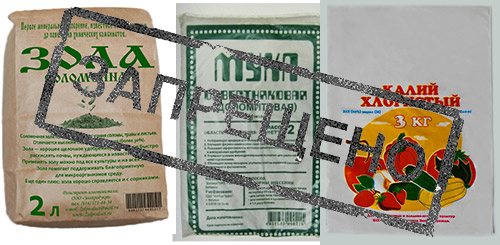

Not only with organic fertilizers, carrots have a difficult relationship, with mineral fertilizers, too, not everything is smooth. You should not feed carrots with ash, dolomite flour and potassium chloride. And all other fertilizers (if there is a desire to apply them) are best applied in the fall when preparing the future beds.
It's better to underfeed than overfeed - this rule for carrots works one hundred percent.
We hope that now the gnarled, shaggy and cracked carrots in your beds will come across less and less.
We wish you success and big harvests!
3. There are many problems with carrots. but). Sowing qualitatively is generally a PPC. Ideally, you need 40-50 seeds per 1 m row. b). Landing scheme. I liked the 2-row - 60-70 row spacing. in). Between 2 rows 25-35 cm. While not strange, less gnarled root crops. Looks like it goes deeper because of the competition. If it is very rare to sow, then colossus grow only for food.
Ruslan
4. I will be glad if it will fit someone. In order not to have a "slingshot carrot", watering must be done strictly along the trenches, aisles.As soon as the carrots came up, they thinned out. Immediately spud it. And these trenches need to be irrigated. Watering is abundant, without getting on the mounds with carrots. Thin out, every 4 cm, leave one. What would be more economical with seeds, sow with pinches every 4 cm. I hope I explained it clearly.
We all love when carrots grow even, large, and have a sweet taste. But having pulled it out of the ground, we notice with chagrin, instead of a large and even root crop, we pull out a gnarled ugly vegetable. It seems that they bought elite seeds in the store, and we prepare the beds on time, and watered it every day, and the carrots grow clumsy. And root crops sometimes take on such a bizarre shape that you are simply amazed.


Of course, such carrots will still go into business: they can be put into autumn harvesting, or simply passed through a harvester, and then frozen for the winter. Or squeeze juice with a juicer. There are many options. But it is still more pleasant to work with a smooth, juicy and sweet root vegetable. I think that many will agree with this.
Why does this happen, what makes the vegetable ugly? It turns out that a number of reasons contribute to this phenomenon, which I will discuss in this article. And also you will learn how to grow it juicy and sweet.
Incorrectly selected variety of carrots
The point is not in the variety itself, or rather, it is not the seeds or poor selection that are to blame, the point is the inconsistency of growing conditions and varietal requirements. For example, we have already mentioned sowing carrots before winter, but it should be noted that during the winter the soil in the beds becomes compacted, and if it is not light enough, then even with high-quality presowing cultivation, carrots are deformed. This usually applies to large-fruited varieties, the deformation is insignificant, only the tip of the root crop can be bent.
How to fix
Carefully prepare the beds in the fall, sow in fluffy ground. Select medium-sized varieties for winter sowing, but suitable for salads and for a bunch.
Why carrots grow clumsy - looking for the reason
Sometimes, when growing carrots, it turns out that the root crop becomes branched, clumsy, looks rather unpresentable. And her taste becomes much worse, even becomes bitter. Let's see why, with proper care, it grows ugly. The main reasons are as follows.
- The surface layer of the soil is highly compacted. The main vertical root cannot break through the dense layer of earth, and begins to grow lateral roots.
- Frequent but shallow watering results in lateral root formation. The fact is that in unfavorable soil conditions, the main root dies off or bends, and the growth of lateral roots, on the contrary, increases. In this case, the roots develop unevenly, thicken, and become deformed.
- An orange vegetable does not tolerate fresh manure and an excess of nitrogen fertilizers. Only 2 years after the introduction of fresh manure can carrot seeds be sown in this place.
- Do not allow large distances between plants when thinning seedlings. In this case, the feeding area of the root crop increases, the lateral roots grow uncontrollably, and the carrot becomes horny.
Carrots have many roots - what to do?
Having dealt with the reasons for the formation of additional roots, first of all it is necessary to eliminate them. What do you need to pay attention to first of all?
The beds must be prepared in the fall. After the vegetables are harvested, the garden bed where you plan to sow carrot seeds must be dug to the depth of the shovel bayonet. From autumn, if necessary, add dolomite or lime flour, wood ash to deoxidize the soil. Sow green manure in the bed, this will improve the structure of the soil, making it looser. Superphosphate is added to the soil in autumn. It is essential for carrots to grow smooth, large and sweet.
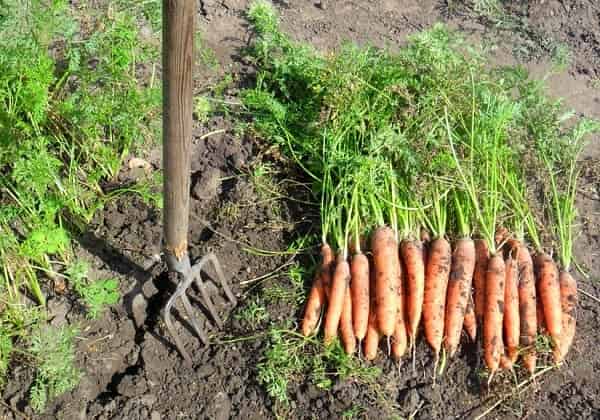

Dig up the soil a second time in the spring 2-3 weeks before sowing the seeds.
If the soil is overdried within a month after germination, the root crop begins to release lateral roots, therefore, the soil should not be allowed to dry out. Usually gardeners water the soil daily or every other day, moistening only the surface layer. Look after watering to see how wet the soil is. Dig a little deeper and you will see that the soil is only 2-3 cm moistened, especially if the weather is hot. Watering is not necessary often, but abundantly, so that moisture penetrates to the very tips of the root crop. After watering the aisles, it is necessary to loosen and weed from weeds.
How to grow large and long carrots
To grow large carrots, there are two important points to consider.


The first dangerous moment occurs at the earliest stages of development. The main root must be preserved throughout the growing season as a central core root. If the plant, at the time of development and gaining length and mass, gets into conditions of drought, excess nitrogen nutrition, or other stressful situations, the growth of the main root in length stops. And the growth of lateral roots, on the contrary, is stimulated.
The second critical moment, which can lead to deformation of root crops, occurs with secondary root growth, that is, in the second half of the growing season. During this period, nutrients begin to be deposited in root crops and new leaves begin to actively grow. If dry weather persists for a long time at this time, the growth of the main root stops. In search of moisture, the plant forms side shoots. During this period, it is necessary to water the soil abundantly to the entire depth of the roots in order to exclude the formation of ugly root crops.
Good watering must be ensured especially in the early stages of the growing season, especially when the weather is dry for a long time. As soon as the leaves of the tops are closed, there is no point in watering the carrots. So that moisture from the ground evaporates less, it is necessary to mulch the aisles.
Plant damage


Carrots bend from drought
Among the reasons why a curve or shaggy carrot grows, there is a violation of the integrity of the plant, especially its root system, including:
- when germination of sprouts was delayed, and the plant was transplanted with a formed root system damaged by transplanting a vegetable crop to a permanent place of growth,
- when the soil dries up at the stage of the appearance of the first shoots or at the initial stage of plant development, which led to the death of the root tip,
- when the thinning of carrot plantings was carried out in violation of the procedure or with a delay, after the first leaf that appeared,
- when the root system has been damaged by pests, including the carrot fly and the bear.
How to feed carrots to make them sweet
For the cultivation of sweet carrots, additional feeding is necessary. According to many gardeners, wood ash will add sweetness. The potassium in its composition affects the taste. Ash is introduced into the soil before digging, and plants are also powdered with it or sprinkled in the aisles. Thus, "two birds with one stone" are killed at once: ash will supply the plant with potassium and at the same time protect it from carrot flies. Experienced gardeners also believe that such fertilization improves the keeping quality of root crops.
In addition, proper watering gives juiciness and sweetness. Of course, the frequency of watering depends on the weather conditions (abundance or absence of rain), on the structure of the soil. On sandy and sandy loam soils, it is necessary to water every week and very abundantly. Fertile and oily soil is also watered every week, but little by little.
But opinions on the frequency of watering carrots are different. In the comments to one article, I found such a review.
Carrots are among those crops that do not need additional watering.As soon as the leaves close between the rows (until this moment, you should water it if it is very dry). Its root tends downward (the root system is pivotal) - this is how nature laid it down - there is always water in the lower layers of the soil, despite the fact that it may be dry outside. By watering carrots, we disrupt the natural growth program - it makes no sense for it to strive downward when there is water closer to the surface - this is how freaks are born. And I simply compensate for the lack of moisture in the dry period by the presence of mulch between the rows of carrots.
I don’t know how you will react to this opinion, although there is some truth here too. But I water on my site exactly as I told you. And it is very rare for me to grow ugly carrots.
Carrots taste bitter - can they be eaten?
Sometimes carrots grow large, even and long. But another problem arises - it becomes bitter. Why does this happen, how to prevent it?
It becomes bitter due to the fact that the shoulders of the root crop look out of the ground, are exposed to sunlight. As a result, the upper part acquires a greenish-brown color, bitterness forms in them. With further storage, the bitterness spreads throughout the root crop and all the carrots become bitter.
To prevent this from happening, it is necessary to dig deeply into the bed in the fall and spring so that the soil is loose. Otherwise, the resulting root crop in dense soil will not be able to break through from top to bottom, so it begins to bulge upward.
Can you eat such carrots? If you eat carrots in the fall, then it is enough to cut off the upper part of the root crop, where its color has changed. The taste of the finished dish will not be affected by this. But after long-term storage, you hardly want to use the bitter fruit for food. Therefore, use such carrots, adding to dishes or to preparations, in the fall.
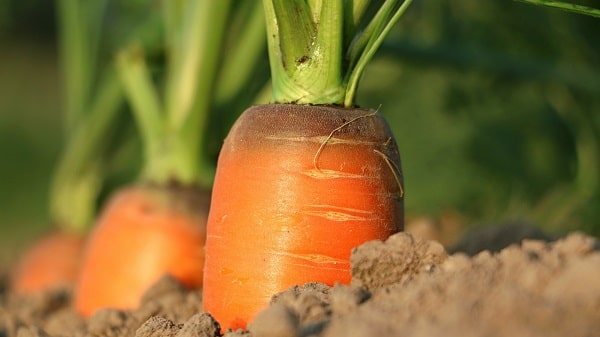

Dear readers, now you know the main reasons for the ugliness of carrots and can avoid mistakes when growing them.


We all love it when carrots are even and smooth, because they are easy to peel.
But what if the carrots have grown clumsy? And why is the carrot horned: with two trunks, on which there are also 3-5 small processes? What kind of miracle is happening and for what reasons?
Naturally, such multifaceted carrots cannot be easily peeled. It will be necessary to cut off all the gnarled shoots and small carrot outgrowths, which, due to the laboriousness of cleaning, may well go into the trash can, and this is already a waste and unforeseen expenses: they have grown, grown, and even a small part of the crop has to be thrown into a bucket.
Excess nutrients
Fertile and loose soil is prepared for carrots. The culture is grown on black soil, loam and sandstone. If most of the soil consists of clay, then it is recommended to prepare a separate mixture, which is filled with a bed.


To improve soil fertility, rotted compost is used. It is administered in a certain amount and only as needed:
| № | Helpful information |
| 1 | there is no need to fertilize chernozem. These are the most nutritious soils. They contain everything necessary for the normal development of any plant. |
| 2 | compost is introduced into loams and sandstones in a volume of 20 kg / m2. It is distributed throughout the site, the earth is dug into 2 shovels. Work is recommended to be performed 3 months before sowing. |
| 3 | for clay soil, a mixture of 20 kg of compost, 10 kg of peat and 5 kg of sand is prepared |
| 4 | before sowing, mineral potash and phosphate fertilizers are applied: potassium sulfate, potassium salt, superphosphate. They improve soil fertility, prevent the development of pathological microflora, fungus, insects |
Organic fertilizers are not used. There are some reasons for contraindications. On organic matter, nematodes and fungi immediately begin to develop, insects appear.
Igor Nikolaev
auto RU
Fresh manure provokes deformation of the root, the development of fruits from the lateral surface of carrots.There are too many nutrients in it, which the roots cannot cope with.
Why does carrots grow horny?
There are several reasons why carrots grow horny:
- Dense soil. Often the soil on our plots is not very fertile and we have been struggling to improve it for more than one year. Particularly unsuccessful for the garden is considered to be sandy loam, which in dry weather becomes as hard as asphalt. Clay, too, carrots consider too hard and begins to "bend", looking for softer moves in it. There is only one way out: loosen, loosen and loosen again. After rains and God forbid showers, a dense crust forms on any soils, which prevents respiration and oxygen saturation, which always negatively affects the quality of root crops. But even in hot weather, which has now been present in many regions for a very long period, the soils become dry and stony due to lack of moisture, no matter how you water them. In such conditions, if you do not loosen constantly, then the carrots will grow not only horny and gnarled, but also short, albeit thick. The yield of short stumps instead of large, long and even root crops is much lower: at times. If you have such a problem soil, then it is imperative to dig it deeply in the fall, preparing a ridge for carrots and in the spring two weeks before sowing. If you are fond of natural agriculture, then do not forget about the basic rule of nature - the soil surface should ALWAYS be covered so that natural moisture is preserved in it: cover with a thick layer of grass in the fall before winter, and in the spring, after the growth of seedlings, with carrots-mulch from sawdust and then in the soil normal humidity carrots will grow both in depth and in breadth without problems and "horns".
- Lime or wood ash applied in spring just before sowing carrots affects the shape of carrots: these are very strong alkalis, and carrots like neutral soil. To deacidify the soil, it is better to apply them in the fall. And such a valuable fertilizer as wood ash includes a lot of trace elements and minerals and, although carrots are happy to consume nutrients, but only from their predecessors and do not like to be fed in the process of growth and development: from excess nutrition, it begins to "wrinkle" ... If you have poor soil, then, of course, the carrots will grow small. Many people believe that carrots can be fed just like all other vegetables: while they are growing. This is not entirely true! All fertilizers must be applied in the previous season: choose for carrots that ridge from such a predecessor for which you fertilized the soil well with organic matter, for example, after cucumbers. Or apply potash and phosphorus fertilizers in the fall when preparing the bed for sowing carrots in the next season. In the fall, it is very good to add superphosphate so that in the next season the carrots will grow large and even.
- Organic introduced in the spring, just like mineral substances, contributes to the horniness and clumsy of carrots, because carrots are fattening from an excess of organic matter. Even compost only needs to be applied in the fall.
- Acidic soil it is also the cause of the curvature of carrot roots as well as ph above 7. For carrots, a neutral ph is needed.
- Repeated overdrying of the soil , which this summer was typical due to hot weather and a small amount of rain, lead to the fact that the root crop begins to look for moisture on the sides, releasing lateral shoots and roots. It is necessary to carry out infrequent, but deep watering. If the soil is light, then it absorbs water well to a depth sufficient for the development of large root crops. But, if the soil is problematic, then only the surface layer is moistened during watering. Pay attention, considering horned and gnarled carrots: lateral outgrowths in the form of small carrots are formed closer to the bottom of the carrot, that is, the carrot releases additional roots where you moisten the soil during watering, but at the depth of the main root there is not enough moisture and it stops growing deeper and begins to grow the root crop to the sides in that layer of soil where there is moisture and nutrition.
Unsuitable soil and disturbed crop rotation
When growing carrots, it is important to comply with soil requirements.Although a vegetable crop is undemanding to the fertility of the land, if vegetables are grown in heavy soil filled with clay and stones, the likelihood that horned or clumsy carrots will grow at times increases. The reason for this is the need for a plant in the process of rooting and development of a root crop to overcome obstacles in the form of compaction encountered on the path of the root system.
When growing carrots in heavy soils with a heterogeneous structure, the growth of vegetables changes direction, as a result, gnarled and horned carrots grow.
Unsuitable soil for the correct formation of carrot fruits is one that has been fertilized with unripe manure or unripe humus. Horned and shaggy carrots grow when limestone, ash powder, potassium chloride are introduced into the soil immediately before planting, or an excess of calcium is allowed.
Organic fertilizers are applied in advance, a year before planting carrots, when growing predecessors.
The appearance of deformed carrot fruits prevents mixing of soil with river sand, which promotes the development of vegetables in the correct forms. It is also taken into account that in order to avoid the ugliness of the fruit, carrots are not planted immediately in loosened soil, but they are waiting for the soil to sink.
Violation of crop rotation
Among the reasons for the deformation of vegetables and the appearance of ugly carrots, non-observance of crop rotation is noted. So, it is recommended to choose a sowing area where tomatoes, cucumbers, onions or garlic have grown before carrot plantings.

